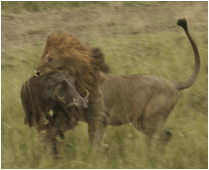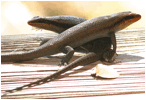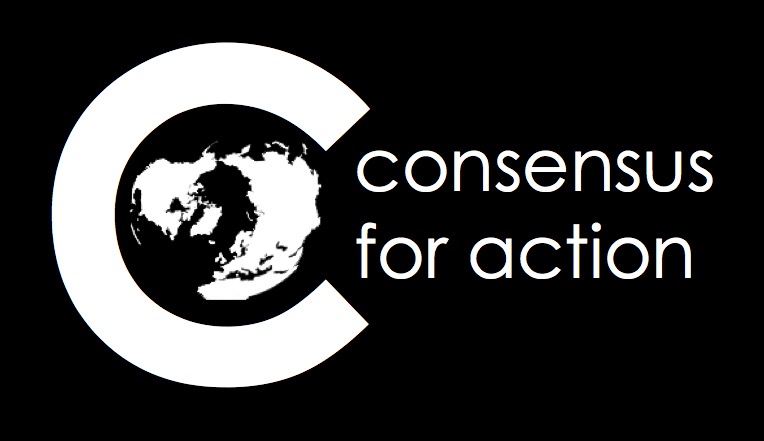By Anthony D. Barnosky, Professor in the Department of Integative Biology, Curator in the Museum of Paleontology, and Research Paleoecologist in the Museum of Vertebrate Zoology at the University of California, Berkeley. His new book Dodging Extinction: Power, Food, Money, and the Future of Life on Earth (University of California Press, Fall 2014) explores in more detail how people can keep wild species and wild places on Earth.
(This is the last blog in the Musings on the Wild series.)
Survival?
I sometimes wonder if I'm a dying a breed. Is this what it feels like to get old? Watching what you love slip away, little by little, until it’s a sorry remnant of what it used to be?
The wild, at least my kind of wild, is certainly a remnant nowadays, but thankfully not yet a sorry one. These days in the Okavango have renewed my faith that. Once again I'm just back from safari, contemplating the quiet of the elephants we saw this morning. They were booking it across the brown grass, heading from one patch of marula trees to the next in single file, with mama in the lead, the matriarch I guess, and her baby second in line struggling to keep up. Was the hyaena crooning in the distance, back in the area from which the elephants were streaming, signaling something that had put them on the move? Was that hyaena why the baby had only a fresh bloody stump where its tail should be? Or were the elephants just in a hurry?

Maybe the eagle we saw knew the answers, but I never will, and that's just fine with me.
I wonder, though, how many other people are there out there like me, who would find it a tragedy if there were no longer places to experience this? Who would understand that without wild places, there would be no more serenity in the world? It's a shrinking wilderness out there, for sure, and maybe our capacity to find happiness shrinks right along with it.
That's my view anyway. I think the only hope for wilderness, for places where wild landscapes and wild species both remain, is if there actually is a critical mass of people who share my view. Those who live in these places certainly do, so that's one good thing. Another is that in my many years and many trips into the wild, I've come across only a tiny minority who, after experiencing such places, do not come away feeling richer for it. I think there's something genetic there.
Of course, that may well be a self-selected sample of humanity. I mean, why visit such places if you don't think it will be something you'd like? I can also remember a couple of people I took on back country trips that ended up downright freaked out by the feeling that there was no grocery store, no doctor, no way to connect with the outside world that didn't take a day or two walking, riding a horse, or bouncing your four-wheel drive vehicle along bumpy two rut roads.
My fear is that the fear of those people is becoming the global norm. There's probably something genetic there too.
Maybe it's that fear that's in a large part causing the wild to disappear. We think of taming wilderness as progress, but maybe it's just the biology of the shifting human gene pool. Maybe deep down, we're evolving from a Homo sapiens defined by our connection to other species, to a new kind of human defined by fear of what we can't control.
 And there's a lot you can't control in the
wild. This morning we came upon a den of
wild dogs. This is the second litter of
pups they've had this season. Turns out
that the first litter, along with their mom, ended up in the stomachs of lions,
all in one fell swoop. Wild dogs are
pretty cagey, but a few minutes of letting your guard down at the wrong time,
and there you have it. You wouldn't be
wrong in calling that a violent death, but then again, we humans have our own
versions of that. Walk into the wrong
neighborhood in just about any big city and let your guard down and you'll see
what I mean.
And there's a lot you can't control in the
wild. This morning we came upon a den of
wild dogs. This is the second litter of
pups they've had this season. Turns out
that the first litter, along with their mom, ended up in the stomachs of lions,
all in one fell swoop. Wild dogs are
pretty cagey, but a few minutes of letting your guard down at the wrong time,
and there you have it. You wouldn't be
wrong in calling that a violent death, but then again, we humans have our own
versions of that. Walk into the wrong
neighborhood in just about any big city and let your guard down and you'll see
what I mean.
So we try to control our lives and the bad things that can happen. We don't walk into those bad neighborhoods. If we do—hell, even if we don't—we buy a gun and learn to shoot it. And we stay out of the wild, or if we do go in there, we arm ourselves and assume every one of the predators there is out to get us.
Yet here's a paradox. One big difference we've noticed between the safari camps and guides in South Africa and Botswana, which is to say, between the faux-wild (game reserves) and the really wild (Okovango Delta): in the truly wild places, they don't carry guns. Here's an interesting story: in our camp now there's a bush buck with a baby. A leopard has been coming into camp pretty much every night trying to get that thing for a meal. Walking to our tent last night, we saw the leopard, maybe twenty yards away. It's a rule of thumb around here that you don't go anywhere at night without a guide that knows the routine, and in this case the routine was simply to shine a flashlight in the leopard's eyes. Sure enough, he cowered behind a tree until we were gone, then went about his business. Later on, we heard the bush buck weakly barking—it sounds a lot like a dog—and a scuffle, and we figured that was all she wrote. But, bush buck and baby were still there today, so I'm not sure what the commotion was about.
Anyway, life goes on, even after those violent events. Now there's a new alpha female in the wild dog den we saw this morning. We heard her new litter of pups squeak and yelp, and watched her coaxing her pack mates, fresh back from the hunt, for more food. A couple of them lazily scratched their fleas and stretched out on the termite mound they've burrowed into and call home.
And, like that family of wild dogs, after every murder in the inner city, every school shooting, we too pick up the pieces and go on.
My point is, I don't think that it's violence we're really running from when we run from the wild, when we try to tame it. It's all about control. And that brings me in a very big circle, because now, in an attempt to save the little wild we have left, we're starting to sneak in more and more control.
 I'm reminded of something we witnessed two
years ago, on Kenya's Masai Mara. We
watched some lions take down a warthog. There were two prides involved, at
least nine lions. One of the males had a
deep gash on his head, presumably from duking it out with another male: we
called him Scarface. Another male suddenly dashed in to take the warthog from
the four lionesses that had killed it, picking up the 200-pound warthog in his
teeth like it was nothing and carrying it off.
This, mind you, was about as wild a place as you are going to find on
Earth; we were at the beginning of the wildebeest migration, the last great
natural phenomenon of its kind.
I'm reminded of something we witnessed two
years ago, on Kenya's Masai Mara. We
watched some lions take down a warthog. There were two prides involved, at
least nine lions. One of the males had a
deep gash on his head, presumably from duking it out with another male: we
called him Scarface. Another male suddenly dashed in to take the warthog from
the four lionesses that had killed it, picking up the 200-pound warthog in his
teeth like it was nothing and carrying it off.
This, mind you, was about as wild a place as you are going to find on
Earth; we were at the beginning of the wildebeest migration, the last great
natural phenomenon of its kind.
Then, almost two years later, an e-mail came into my in-box, from one of the travelers who had been with us on that trip. He'd run across a news article that said one of the lions in Scarface's pride had been pretty badly torn up in a fight. A picture showed this lion with a huge flap of skin hanging off its side, below a bloody patch of muscle and ribs about the size of a of dinner plate, maybe bigger. The gist of the article was that the injured lion had been anesthetized by a team of veterinarians; its side had been stitched up, and it was doing well.
So there we go again, exerting control, but maybe this time it was for the right reasons? For better or worse, we gave that lion a chance to fight another day because lions, like many other large predators, are now so few in number they are in danger of extinction. Like me, maybe they're a dying breed.
But, maybe we can turn that around. Stitching up a lion is no easy or cheap feat. We can argue about whether or not that was the right call, but the fact that somebody is still willing to take that trouble on makes me know there are others like me out there. And if there are enough of us, all willing to do what we can, the wild might yet survive. Which would mean, our version of Homo sapiens, like the wild we love, also would live on.

I'm keeping my fingers crossed that all works out. Meanwhile, I just finished watching a four-foot-long monitor lizard glide out of the tall grass in front of me, and two smaller lizards going through an elaborate courtship ritual on the tent porch. For now, those things will have to be enough.

